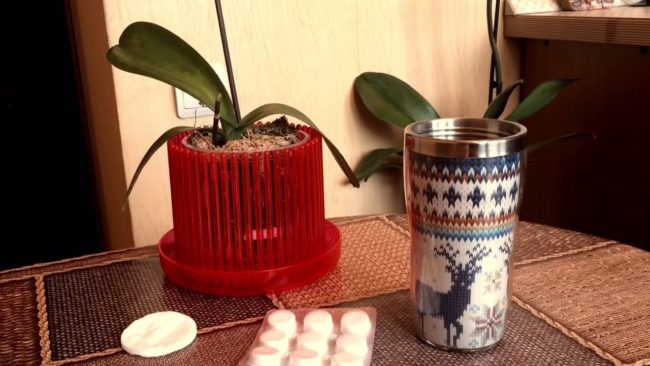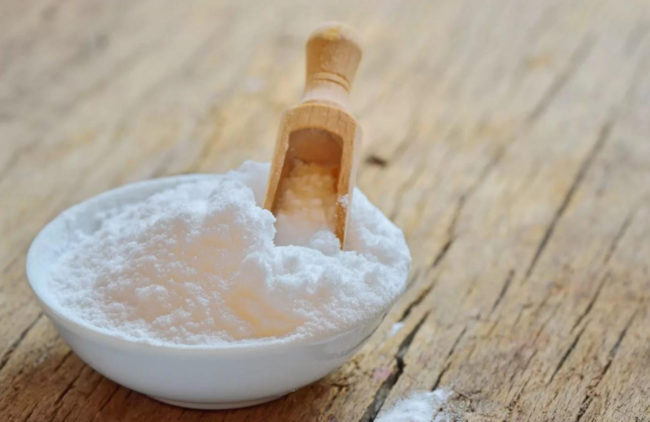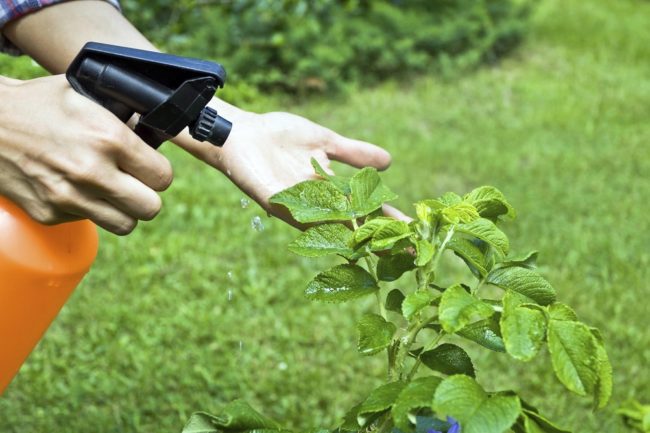Almost every house has flowers, they have a beneficial effect on the microclimate in the room, delight with their beautiful flowering. But in order for flowering to be long, it is necessary to properly care for indoor plants: watering in time, protect from direct sunlight, monitor the temperature in the room and make top dressing. Care will help amber acid for plants.
Content
Even a novice-flower lover will deal with the intricacies of using acid. But in order to get maximum effectiveness from the drug, it is necessary to familiarize yourself with the rules of use.
Amber acid for flowers
What is this drug? A small amount of acid is contained in some products and substances: for example, in brown coal, in some plants and organisms of animals, as well as in amber. You can buy this useful product for plants in a pharmacy or store. Amber acid is sold in tablets for plants, as well as in powder.
There is an opinion that acid is the remnants of the processing of stone - amber. The stone has positive properties not only for people, but for plants it will also be useful. But this is rather a myth, not a reality, because in order to put the production of acid on a massive flow, it is necessary to have a lot of amber, and this is impossible. Therefore, what we see on the shelves of pharmacies and stores is nothing more than a product obtained from chemical production waste (from brown coal) or dicarbon acid.
Outwardly, acid is a transparent fine -crystalline powder, it can be white. If you taste acid, it will taste the same as lemon. The smell of this substance is absent.

The substance is safe not only for plants, but also for humans, as well as for animals. If it enters the soil, then it is completely destroyed and does not harm the environment.
Amber acid is well dissolved in water and any liquids, in an alcohol solution and ether.
What is also needed by amber acid?
For a person, this substance is indispensable, each living organism produces a certain amount of acid (for example, the body of an adult produces about 300 g), it is easy to replenish the reserves, consuming fruits, vegetables and dairy products.
Acid is a substance that helps cells produce oxygen. For humans, acid is a useful product that helps stop the aging process, improve the condition of the body, skin, hair. And for plants, amber acid is a real salvation.
The benefits and properties of amber acid:
- each plant, especially indoor, needs to help. Spraying with acid will help to avoid diseases, improve flowering, strengthen weak plants;
- acid is not a fertilizer, but a substance that will help indoor plants take more nutrients (when adding tops);
- amber acid in gardening is an indispensable substance. Crystals help improve the composition of the soil, destroy toxic substances, neutralize pesticides and other harmful products that accumulate in the soil over the years.
- the introduction of a certain dose of crystals will increase the content of nutrients in the soil, neutralize nitrogen;
- also, acid is a kind of catalyst: it helps to resist negative natural factors. For example, when the humidity level is increased or vice versa, when the air is too dry, the air temperature is increased in the room or, conversely, reduced;
- if you constantly use acid in the care of indoor plants, you can strengthen their immunity so that the plants are not exposed to diseases;
- amber acid is a kind of only salvation for all plants, including colors that were attacked by pests and diseases. If you spray with the solution of the aboveground part, then the root system of any plant will recover faster. In addition, acid is an excellent growth stimulator, so it is easy not only to strengthen the plants, but also to improve their growth, as well as accelerate flowering;
- the seeds are even soaked in acid before planting to activate metabolic processes.

Amber acid is sold in pharmacies without a prescription, it costs literally a penny, is available in different forms of release (tablets, capsules, powder, liquid). What each beginner flower breeder should know: that the substance is not harmful to plants. That is, it is difficult to achieve an overdose, because the plant will take as much as it needs. Therefore, you can process any parts, without fears that acid may not get the wrong way (this is the main rule when making chemical tops). That is, an accidental ingress of acid on flowers, leaves and young shoots will not harm the plant.
Acid is not able to accumulate in the soil and air, in the light it breaks up almost instantly.
Amber acid for indoor plants is a cure for all pests and diseases. If you regularly water plants with diluted acid, your indoor favorites will always delight with their beauty and long flowering.
And the disadvantages? They also have, this is a weakly expressed action, that is, if you need to take emergency measures, then most likely the acid will not work the way we would like. And yet, if you systematically add acid to the soil, then it can acidify it, so from time to time you will have to play the soil.
How to dilute amber acid
Before you start breeding powder or tablets, you need to know that you need to work only in gloves and protective clothes. If the acid enters the skin, it is necessary to immediately perform the treatment: prepare a solution of baking soda (for a glass of water 1 tsp), rinse the affected area with this solution, rinse abundantly with water from the tap. If an acid solution hit the mucous membranes, then you need to urgently rinse them with water.
Cooking a solution of amber acid:
- Take 3 tablets and prepare a convenient container for breeding immediately. Pour 1 liter of water into a bottle, add 3 tablets, mix. It will turn out not a very concentrated solution that can be administered to the roots, both adults, stronger plants, and young. Watering the soil must be abundantly so that it is well saturated. The same solution can be used before planting plants. For example, soak the seeds for an hour.
- Preparation of a working solution from the powder of amber acid: take 2 g of powder, pour 1 or 2 liters of cold water, mix. In order for the powder to dissolve well, you can do this: take the specified amount of the drug, pour a small amount of warm water (for example, 5 tbsp), then the diluted drug is brought to the desired volume using cold water.

Spraying with amber acid: the finished solution must be used within 1-3 days, then it will not be beneficial. Is it possible to store amber acid for a long time? The finished solution is not stored for a long time, the maximum of the 3rd day. You need to keep the bottle in the cabinet, in a dark place. You can not hold the solution next to drugs, even if the container is tightly fired. It is necessary to store the finished solution at room temperature, but not higher than +25 degrees. When stored for more than 3 days, the beneficial properties of the drug are destroyed, and it will not be beneficial for plants.
Feeding plants with amber acid
A acid diluted with water is used in different ways: plants can be watered, soaked, sprayed and fed.
Methods of use:
- spraying plants. A pill of acid is taken, it is diluted in warm water in half a glass, a concentrated solution is poured into a jar, it is added with defended water. Pour the finished solution into a container with a spray, spraying plants. Amber acid is used to process tomatoes and other garden crops, as well as for the processing of indoor plants. Indoor plants are treated once every 2-3 weeks, but not more often;
- soaking rhizomes is the maximum rating time from 1 to 2 hours. If you can’t soak only the roots, then they can be sprayed. The same solution of amber acid is used as for watering plants;
- the pre -sowing processing of seeds with amber acid for the processing of cucumbers and other garden crops: sowing material is soaked in the finished solution at night (the solution is made of 1 liter of water and 1 tablet). After exposure, the seeds must be dried and only after that you can start landing;
- amber acid for the garden is widely used: for example, potatoes are sprayed with a solution to restore plants faster after processing from pests and diseases;
- amber acid for tomato will improve the quality and yield of tomatoes. If there is a lot of nitrogen in the soil, the introduction of an acid solution will help neutralize nitrogenous substances. Tomatoes are sprayed after sunset 3 times for the entire growing period: once before flowering and the following twice - after flowering.
Amber acid is widely used in the garden for growing different garden crops: tomatoes, pepper, cucumbers and eggplant, as well as for treating fruit trees. The trees are treated with a standard solution (1 tablet per liter of water) before flowering to protect the trees from the attack of pests, diseases and to stimulate the growth of shoots.

Amber acid for orchids
Lovers of orchids call the acid living water, this is so, because the solution for these delicate plants becomes a real salvation.
If you water orchids according to all the rules, such a simple manipulation will achieve excellent results:
- accelerate plant growth;
- strengthen the root system of a young flower;
- accelerate photosynthesis;
- the plant will develop faster, throw more shooters, bloom longer.
But, here you need to understand that other fertilizers will not be able to replace this substance completely, so you should not refuse complex care of orchids.
How to water flowers with amber acid:
- It is advisable to hold the roots during a transplant in the solution for 30 minutes, then be sure to dry before the pot, dry it well. The new soil during transplantation should be sterile.
- How to process the leaves of the orchid: take a tissue napkin, moisten in the working solution (1 g or 1 pill of acid for 1 liter of water), process the leaves with a damp cloth, be sure to remove all droplets of the product from the leaves.
- One or twice a month, plants must be sprayed from the sprayer. How to dilute amber acid for an orchid: take 1 liter of water and 1 g or a tablet of acid, the tablet must first be dissolved in half a glass of water (temperature 36-38 degrees), then pour the concentrate into a spray water with cold water, shake the container well. Regular spraying (no more than 1 time in 3 weeks) will help stimulate the growth of young shoots. If a fresh solution remains after treatment, do not rush to pour it into the sink, pour the roots of orchids and treat other indoor plants. Each time it is advisable to prepare a fresh solution.









Comments
a couple of years ago, there was no side of metrogils from the same problem, there were no side effects ...
I’m not a fan of peeling at all, it saves from acne of metrogil, it also smoothes it ...
Great article! ...
I take the second course of the Capsules Climafite 911. The tides went very quickly. It became calmer, irritability went away and I sleep well ...
i also noticed - it is worth nervous, everything immediately affects the face. Therefore, I try to avoid conflicts and unpleasant people. From creams I like miaflow from wrinkles - smoothes not only small flies ...